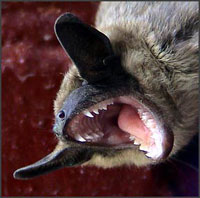Epidemic of mysterious illness kills thousands of bats in US
By Margarita Snegireva. An epidemic of some strange illness spread among bats in northeastern U.S. and caused death of thousands of animals. New York state wildlife officials say that this may be fraught with extinction.

At eight caves in New York and one in Vermont , scientists have seen bat populations plummet over two years. Most bats hibernate in the same cave every winter, keeping annual counts consistent. A cave that had 1,300 bats in January 2006 had 470 bats last year. It recently sheltered just 38.
At another cave, more than 90 percent of about 15,500 bats have died since 2005, and two-thirds that remain now sleep near the cave's entrance, where conditions are less hospitable. Scientists don't know what's causing the deaths, and biologists wearing sanitary clothing and respirators to prevent the spread of disease are collecting the dead for testing as part of a state and U.S. effort.
Bats are natural reservoirs or vectors for a large number of zoonotic pathogens including rabies, severe acute respiratory syndrome (SARS), Henipavirus (ie. Nipah virus and Hendra virus) and possibly ebola virusTheir high mobility, broad distribution, social behaviour (communal roosting, fission-fusion social structure) and close evolutionary relationship to humans make bats favourable hosts and disseminators of disease. Many species also appear to have a high tolerance for harbouring pathogens and often do not develop disease while infected.
Only 0.5% of bats carry rabies. However, of the very few cases of rabies reported in the United States every year, most are caused by bat bites. Although most bats do not have rabies, those that do may be clumsy, disoriented, and unable to fly, which makes it more likely that they will come into contact with humans. Although one should not have an unreasonable fear of bats, one should avoid handling them or having them in one's living space, as with any wild animal.
Due to the risk of rabies and also due to health problems related to their faecal droppings (guano), bats should be excluded from inhabited parts of houses. For full detailed information on all aspects of bat management, including how to capture a bat, what to do in case of exposure, and how to bat-proof a house humanely, see the Center for Disease Control's website on bats and rabies. In certain countries, such as the United Kingdom, it is illegal to handle bats without a license.
Where rabies is not endemic, as throughout most of Western Europe, small bats can be considered harmless. Larger bats can give a nasty bite. They should be treated with the respect due to any wild animal
Subscribe to Pravda.Ru Telegram channel, Facebook, RSS!


